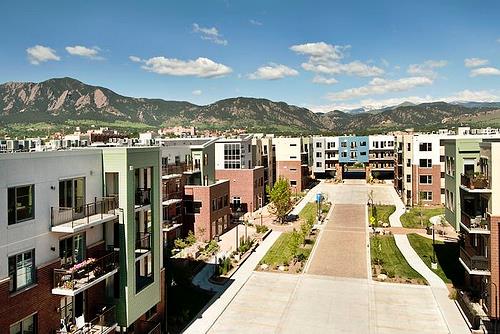Editor’s note: PLAN-Boulder County has issued a report entitled Does Dense Make Sense? This is the first part in a six part series extracted from the report.
- Image from http://www.thepeloton.com/
Colorado and Boulder County have a long history of continued growth. Between 1970 and 2008, Colorado’s population grew 125%, outpacing the annual, national rate for 38 straight years. Colorado is estimated to be among the top 20 states for job growth in 2010 and will see corresponding levels of population growth. In fact, for the next 30 to 40 years, the fastest growing metropolitan areas in the United States are predicted to be in the western states along the mountain ranges — cities such as Phoenix, Salt Lake City and Denver.
Boulder is the densest city in the Rocky Mountain west for cities with populations greater than 50,000.
Boulder County has experienced a series of population booms, with the rate of growth peaking in the 1960’s and 1970’s.
Table 1. Boulder County Population Growth
| Census | Population | Increase/Decade (percent) |
| 1900 | 21,544 | |
| 1910 | 30,330 | 40.8 |
| 1920 | 31,861 | 5.0 |
| 1930 | 32,456 | 1.9 |
| 1940 | 37,438 | 15.4 |
| 1950 | 48,296 | 29.0 |
| 1960 | 74,254 | 53.7 |
| 1970 | 131,889 | 77.6 |
| 1980 | 189,625 | 43.8 |
| 1990* | 226.374 | 19.4 |
| 2000 | 271,651 | 20.0 |
| Est. 2008 | 293,161 | 7.9 |
Projections for growth inside the city limits of Boulder (Area I) anticipate that Boulder will reach “buildout” in 2035 with a population of 119,400 based on current zoning.
Table 2. Existing and Projected Housing Units, Population and Employment for the City of Boulder (Area I)
| Existing 2010 | Projected 2035 | Projected Buildout | |
| Housing Units | 43,878 | 49,900 | 49,900 |
| Population | 103,600 | 119,400 | 119,400 |
| Employment | 96,800 | 116,000 | 160,800 |
If Boulder County does in fact continue to grow, where will all this growth occur? Some people would like to see increased densities inside the City of Boulder. While areas inside the City of Boulder certainly have opportunities for commercial and residential redevelopment, it is interesting to note that with over 4,000 persons per square mile, the City of Boulder is already denser than Denver (3,940 persons per square mile) and is the densest community in the Rocky Mountain west among cities with more than 50,000 people.
Table 3. Density Comparisons of Towns and Cities in and near Boulder County
| City | Area (sq. mi.) | Current Pop. | Density (persons per sq. mi.) | Projected Population (year) | Projected Density (persons per sq. mi.) |
| Boulder (Area I) | 25.48 | 103,600 | 4,066 | 119,400 (2035) | 4,686 |
| Denver | 154.9 | 610,345 | 3,940 | N/A | N/A |
| Erie | 48 | 18,150 | 378 | 25,650 (2015) | 534 |
| Lafayette | 8.9 | 26,448 | 2,972 | 28,385 (2013) | 3,189 |
| Longmont | 25.65 | 86,303 | 3,365 | N/A | N/A |
| Louisville | 7.9 | 19,004 | 2,406 | N/A | N/A |
| Lyons | 1.2 | 1,915 | 1,596 | N/A | N/A |
| Nederland | 1.6 | 1,500 | 938 | N/A | N/A |
| Superior | 4.25 | 12,500 | 2,941 | 17,000 (~2020) | 4,000 |
Boulder’s current population of 103,600 includes 29,000 University of Colorado students. According to the University’s Flagship 2030, the student population could grow by another 8,140 students.
It is also interesting to compare the City of Boulder with other communities across the United States of similar size, student population and political/environmental orientation. Cities such as Palo Alto, Fort Collins, Madison, Missoula, Boise, and Eugene all have much lower densities than Boulder does. Ann Arbor’s density is approximately the same as Boulder’s. The density figures listed below are night time figures, meaning the density that one would see at the end of normal commute hours. The City of Boulder’s daytime density is higher during the day because the City experiences a net influx of about 40,000 people each day. Boulder’s daytime density could be as high as 6,000 persons per square mile.
Table 4. Density Comparison between the City of Boulder and Other Similar Communities
| City | Area (sq. miles) | Current Population | Density (persons per sq. mile) |
| Palo Alto, CA | 25.98 | 60,171 | 2,316 |
| Fort Collins | 53.38 | 138,736 | 2,599 |
| Madison, WI | 84.7 | 235,626 | 2,781 |
| Missoula, MT | 23.9 | 68,202 | 2,854 |
| Boise, ID | 64 | 205,314 | 3,179 |
| Eugene, OR | 40.54 | 153,231 | 3,779 |
| Boulder | 25.48 | 103,600† | 4,066 |
| Ann Arbor, MI | 27.7 | 112,852 | 4,074 |



